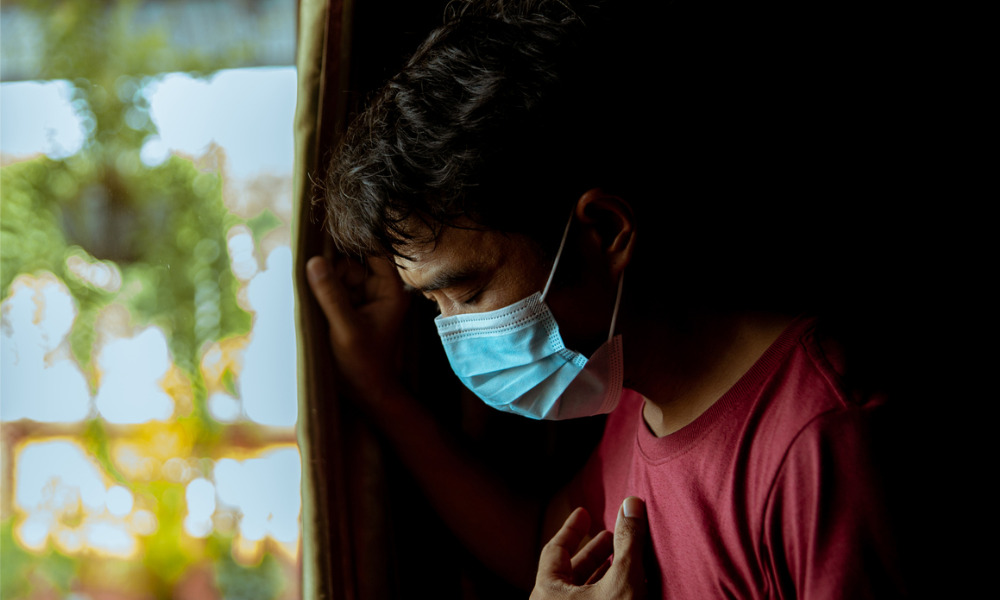Nearly half of employees in the U.S. took time off work to deal with long COVID

With COVID (hopefully) behind us, many organizations are looking to a new future unencumbered by lockdowns, masking and other preventative measures.
But for those unlucky enough to catch the deadly virus, the future is not so certain.
Post-COVID-19 condition (PCC) or long COVID can not only hurt the people suffering from the condition and their family, but it could also have a significant impact on the economy, according to a report.
This affects about 10 per cent to 20 per cent of those who get acute COVID-19 infection, according to Dr. Mona Nemer, Canada’s chief science advisor.
And while acquiring the COVID-19 virus can have a dilapidating effect on an individual, the effect on those who experience long COVID is equally concerning, says Nemer.
Impact of long COVID
Common symptoms that people with long COVID experience include: memory loss, blurred vision, mood disorders and neuropathies, may reflect irreversible cellular changes observed in aging or in some neurodegenerative disorders.
“Thus, PCC has the potential to become a mass-disabling event given the highly transmissible SARS-CoV-2 Omicron variant in circulation and the unpredictability of evolving future variants,” says Nemer.
“Some patients have not recovered two to three years after the initial infection, and it is uncertain whether a proportion may ever fully recover.”
Those who can no longer work can file claims for social assistance, disability supports and insurance, says Nemer.
“Future socio-economic implications may be far-reaching and require planning and monitoring,” says Nemer.
“Analysis of the socio-economic impact of PCC from other countries, including the United Kingdom and the United States, indicates significant impacts on the labour market and the Gross Domestic Product (GDP), in addition to health costs and demands.”
Nearly half (48 per cent) of employees in the U.S. had to take time off work to deal with “long COVID,” according to a report from workforce inclusion platform Inclusively released in December. This translated to about 1.5 million Americans off work that month, reported The Guardian.
Among employees, the Inclusively survey of more than 500 U.S. workers also found that people dealing with long COVID also reported:
- having depression or anxiety (45 per cent)
- not being able to work as many hours (39 per cent)
- changing where they worked (31 per cent)
The number of job seekers requiring workplace accommodations to manage a long COVID diagnosis is growing, according to Inclusively CEO Charlotte Dales.
But not all employers are very accommodating to employees with this condition, according to a previous study from Power, which revealed that only 55 per cent of the respondents said their workplace accommodated employees with long COVID.
One in eight of long COVID-hit workers also got denied of their application for disability protections and benefits, according to the report.
Stigma of disease
Beside the physical issues, people are in bad shape in employment and life overall, finds another study.
“We found that people with higher levels of stigma had more symptoms, lower function, reduced quality of life, and a greater chance of unemployment due to disability,” says Ron Damant, professor in the Faculty of Medicine & Dentistry at the University of Alberta.
“People says they were not allowed to return to work, ostracized from friends and family, subjected to unnecessary and humiliating infection control measures, accused of being lazy or weak, or accused of faking symptoms.”
Given the uncertain nature of COVID, employer must come up with ways to mitigate the impact and help the affected employees cope.
“People says they were not allowed to return to work, ostracized from friends and family, subjected to unnecessary and humiliating infection control measures, accused of being lazy or weak, or accused of faking symptoms,” says Damant, who hopes that people will become more empathetic and open-minded as more is understood about long COVID and the impact of stigma on patients.
At least 65 million individuals worldwide are estimated to have long COVID, with cases increasing daily, according to a separate study published on the Nature Reviews Microbiology website.
‘Getting on with it’
Australia has more than 80,000 active COVID cases, with New South Wales leading the way — more than 47,000 people there are suffering from the disease.
Despite the high figures, there is now a general sense of “getting on with it” and learning to live with the global illness, with employers relaxing compulsory vaccine mandates.
“As an employer, we do not have the right to force a COVID-19 vaccine mandate, but we can ask employees to be vaccinated as a condition of employment,” says Kasen Somana, founder of Signature Dentistry.
Somana encouraged all staff to get vaccinated as soon as they were eligible.
“The impact on our workforce with this policy has been positive, as it shows my staff members that I am committed to their safety and well-being,” he said.
End of emergency?
In one U.S. state seems to be signalling that COVID is over. After nearly three years, California’s COVID-19 state of emergency has finally expired.
“Throughout the pandemic, we’ve been guided by the science and data – moving quickly and strategically to save lives,” says Gov. Gavin Newsom.
“The State of Emergency was an effective and necessary tool that we utilized to protect our state, and we wouldn’t have gotten to this point without it. With the operational preparedness that we’ve built up and the measures that we’ll continue to employ moving forward, California is ready to phase out this tool.”
While this might be good news for now, 7.5 per cent of U.S. residents reported symptoms of COVID long after they were first infected, according to CDC figures, which will certainly be something that employers will have to cope with in the future.





